Japon y el agua (en)
WATER IN JAPANESE
CONTEMPORARY ART:
THE WORK OF ARTIST TOMOHIDE IKEYA
Alejandra Rodríguez Cunchillos
University of Zaragoza
University of Zaragoza
The sea in spring
rises and falls all day
rises and falls
rises and falls all day
rises and falls
Buson (1715-1783)
THE APPRECIATION OF NATURE and its representation in the arts has been and continues to be a constant in Japan. Throughout history, numerous Japanese artists have addressed this subject, particularly the different behaviors of water, through scenes depicting human coexistence with this element.1
In this sense, water inspired distinguished poets, like Buson Taniguchi (Settsu, 1715 - Kyoto, 1783), who reflects the attitude of water in the haiku preceding this article. Similarly, in other arts we find many Japanese authors who incorporate this theme so deeply rooted in their culture. Such is the case of the renowned Katsushika Hokusai (Tokyo, 1760 - Tokyo, 1849), who created the print "The Great Wave off Kanagawa" from the series "Thirty-six Views of Mount Fuji." This is possibly one of the most famous works in Japanese art history. The crest of the wave about to break over the sailors demonstrates the power of nature, its violence, and the impossibility of human control. We must keep in mind that Japan is part of the Pacific Ring of Fire, situated in a zone of high seismic and volcanic activity, which is why tremors are very frequent and, consequently, tsunamis occur. For this reason, this print has become an expression of the country's geology and likewise its emblem.
In this sense, water inspired distinguished poets like Buson Taniguchi (Settsu, 1715 - Kyoto, 1783), who reflects the attitude of water in the haiku preceding this article. Similarly, in other arts we find many Japanese authors who incorporate this theme so deeply rooted in their culture. Such is the case of the renowned Katsushika Hokusai (Tokyo, 1760 - Tokyo, 1849), who created the print "The Great Wave off Kanagawa" from the series "Thirty-six Views of Mount Fuji." This is possibly one of the most famous works in Japanese art history. The crest of the wave about to break over the sailors demonstrates the power of nature, its violence, and the impossibility of human control. We must keep in mind that Japan is part of the Pacific Ring of Fire, situated in a zone of high seismic and volcanic activity, which is why tremors are very frequent and, consequently, tsunamis occur. For this reason, this print has become an expression of the country's geology and likewise its emblem.
Water in Contemporary Japanese Art
Contemporary Japanese society continues to show a close proximity to nature and a special sensitivity to its aesthetic values. Thus, this relationship is manifested in contemporary art, where water remains an inspiring element, a medium for creating artworks, or their protagonist.
If we pay attention to this issue, we find that in post-1945 art,2 many artists frequently use water during the creative process or as a main theme.
Another well-recognized artist in the current scene for whom water is the protagonist of his work is Hiroshi Sugimoto (Tokyo, 1948). Since the 1980s, the author has been photographing the sea and sky, with "Seascapes"3 being one of his most famous series.
On the other hand, in 1998, artist Tatsuo Miyajima (Tokyo, 1957) created an installation in an old house (called Kadoya) on Naoshima Island, Japan, titled "Sea of Time '98."4
Likewise, artist Jun Nguyen-Hatsushiba (Tokyo, 1968) has created several video installations in aquatic settings. An example is "Memorial Project Minamata: Neither Either Nor Neither - A Love Story" from 2003.5
Similarly, and recalling the first work cited, "The Great Wave off Kanagawa," Manabu Ikeda (Saga Prefecture, 1973) created "Foretoken" in 2008. He was inspired by those great waves that occasionally strike Japan. A work presaging the 2011 Tohoku earthquake, in which water swept away everything in its path. Again, water and its importance in Japan is evident in art.
Tomohide Ikeya
Linking to the place of the wave, Kanagawa, we must situate the Japanese artist who is the focus of this study, Tomohide Ikeya.6
Unlike many artists in the contemporary sphere, Ikeya did not receive traditional artistic training; nevertheless, from childhood, he was interested in manga, anime, and Japanese cinema, hobbies that increased during his adolescence.7
In 2001, Ikeya left his previous job and joined photographer Katsuji Takasaki's CARATS studio as an employee. Master Takasaki (Tokyo, 1947) established his own photography studio in 1976 and in October 1990 changed his company's name to CARATS. Takasaki is world-renowned for his ability to capture the beauty of Japanese cities, primarily Kyoto and Nara. He is also one of the most in-demand authors for commercial photography projects in Japan and the United States, where he has been commissioned for several works with international Hollywood artists.8
While the artist was scuba diving, he saw a photographer with his camera underwater portraying the seabed. Ikeya felt he wanted to do the same, but not in a documentalist sense; what interested him was capturing images in the water and creating a discourse from them. In an interview, he told how he experienced this: "By chance, I was invited to go diving, and when I saw that underwater world, it captured me immediately. The various phenomena and life forms that exist only in water and the beautiful interplay of water and light gave me a strong sense of euphoria and emotion." After reflecting on this issue, he began working as a freelance photographer. It is from then on that Ikeya's work becomes really interesting for this study.
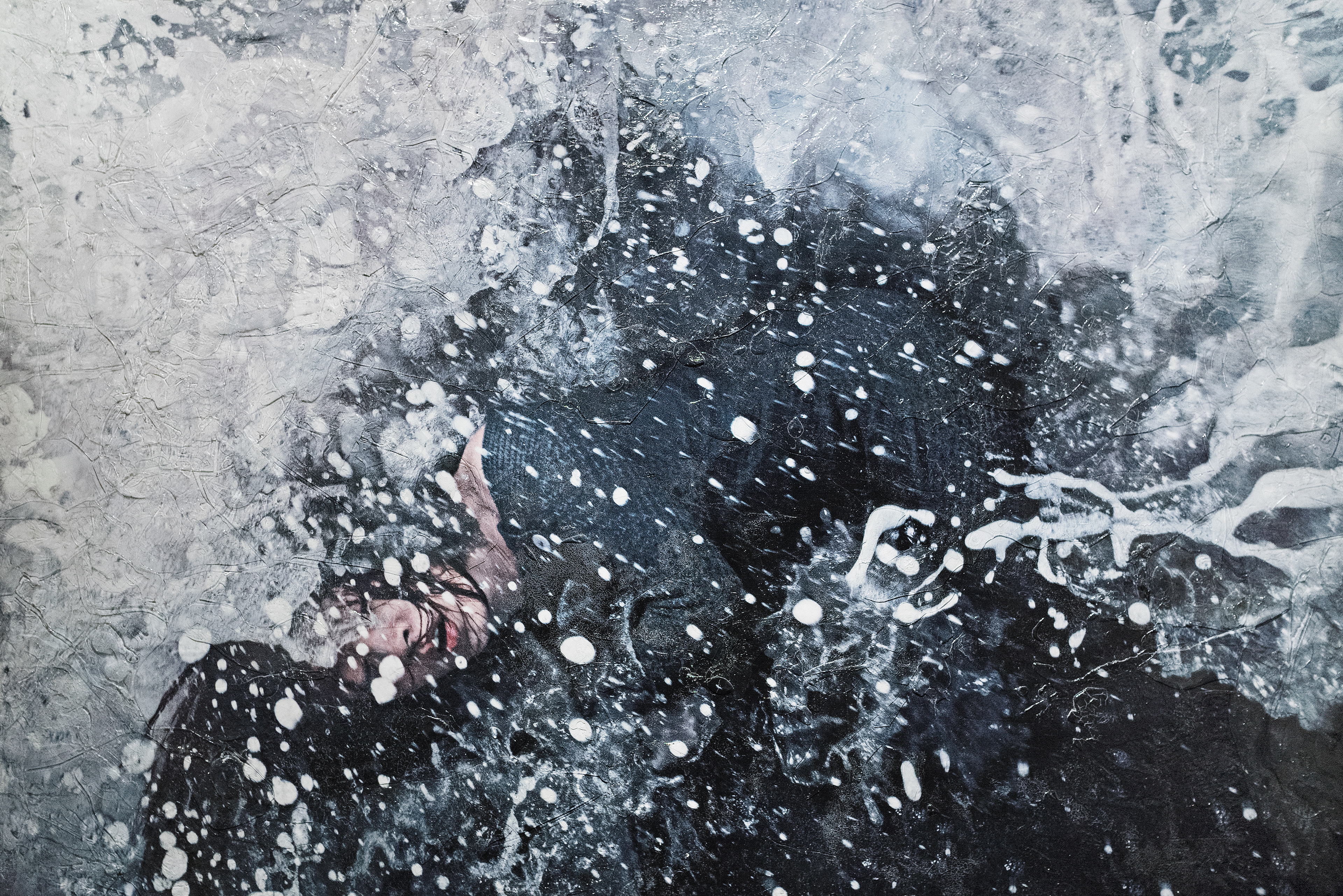
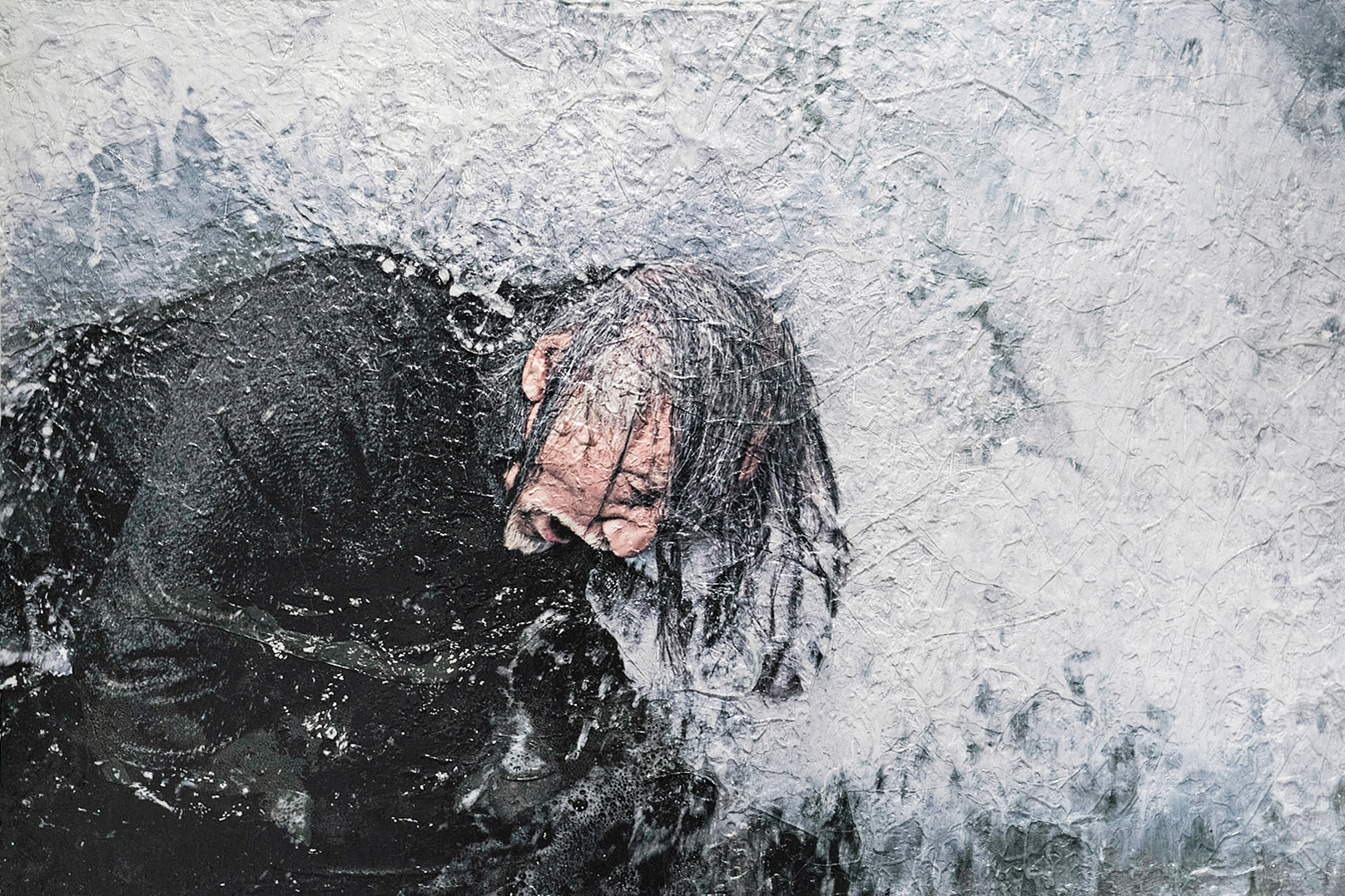

The Artist's Work and Series
Thus, the artist captures in his works this theme so deeply rooted in his culture—water and the human being—and presents it to us through contemporary supports and techniques: it is the main axis of his work. In his photographs, both elements cross paths in a perfect symbiosis and are the protagonists of three series known as Wave, Moon, and Breath. In all of them, Ikeya questions the concept of 'control' and its loss, of man with water, seeking different human reactions. However, none of them abandons the elegant aesthetics and poetic sense that characterize his work.
Regarding the creative process, the artist approaches his work as follows: First, he meticulously plans the work to be developed through sketches and other supports, although he is open to possible changes that may occur in the space; we must remember that some works are carried out submerged in deep water tanks, and the spontaneity and reactions of the models to certain situations can be very different. These results are usually the most interesting. Therefore, Ikeya always starts from an idea, a vision, a theme, and tries to balance it with chance, which will always be present. To execute these photographs, the artist enters the water with the fewest possible tools, to be at the same level as the models, to endure in the aquatic medium for the longest time, and to be able to take the photographs. This would be his artistic approach and the way to produce his work. As for the concept, he tries to highlight the existing link between water and the human being. In his artistic statement, Ikeya explains:
"I'm a photographer who has a concept of 'control' for my work. Water is one of the 'uncontrolled' things which the human being never can do. I had a lot of opportunities to think about 'water' while doing scuba diving in several countries as a hobby. The beauty of sunshine viewed from underwater, daily life of aquatics, and me as human just being able to see their world for a moment... We thought humans could control water if we had lots of equipment and cared for risks in water, but humans never be able to live in water. And we also never be able to live without water. Water doesn't only give life but also takes life. On the other hand, water is not the Mother of Creation or the Master of Destruction; it's just there as 'water'. Water is a very philosophical existence even being 'just water'. I had been fascinated with water more and more, and I had gotten a zeal for expressing it. It is one of the reasons I became a photographer, so I have been creating my works which have a relation with water. I'm expressing 'enthusiasm for life' through photography throughout the figure of Water and Human."
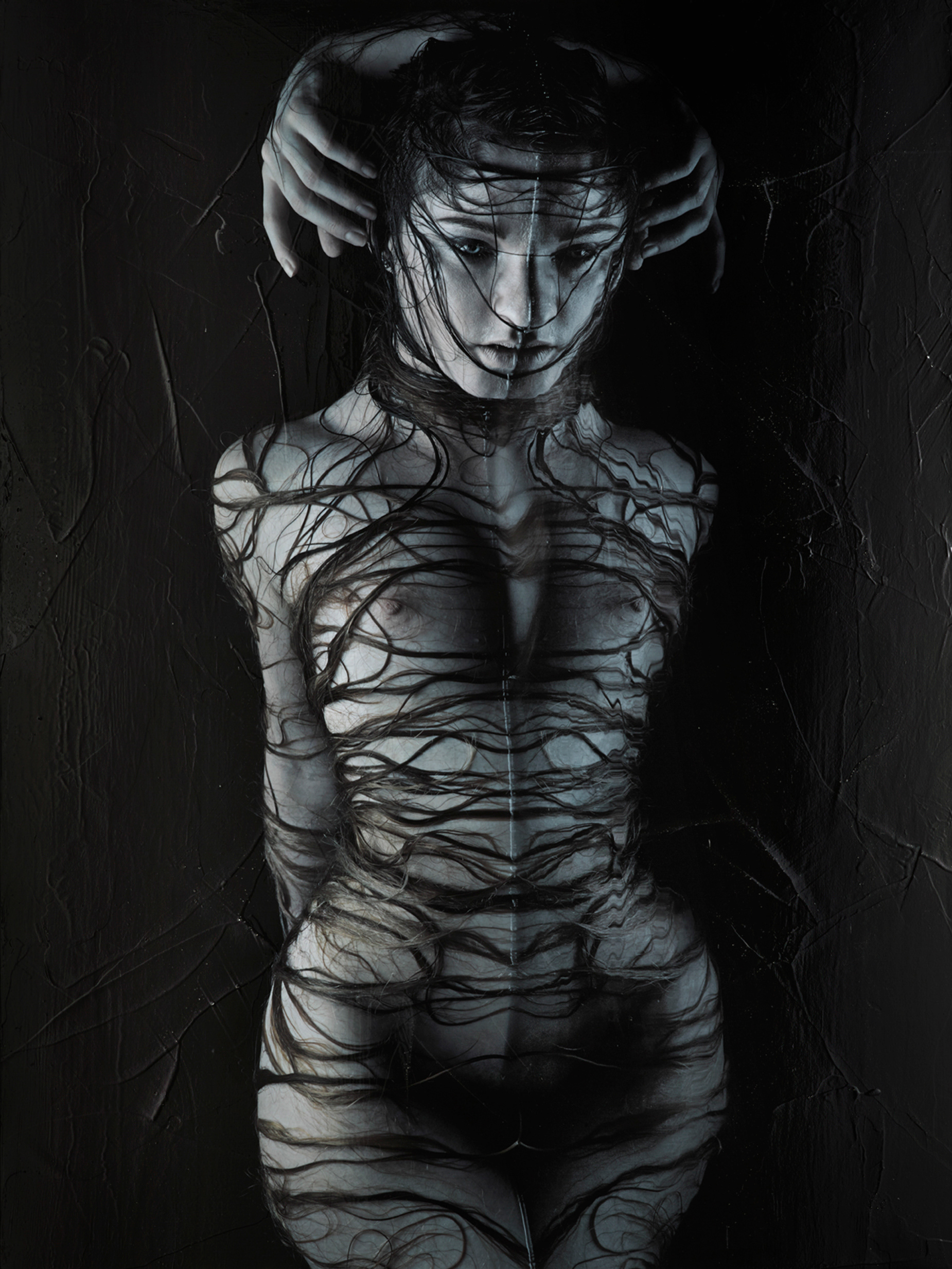
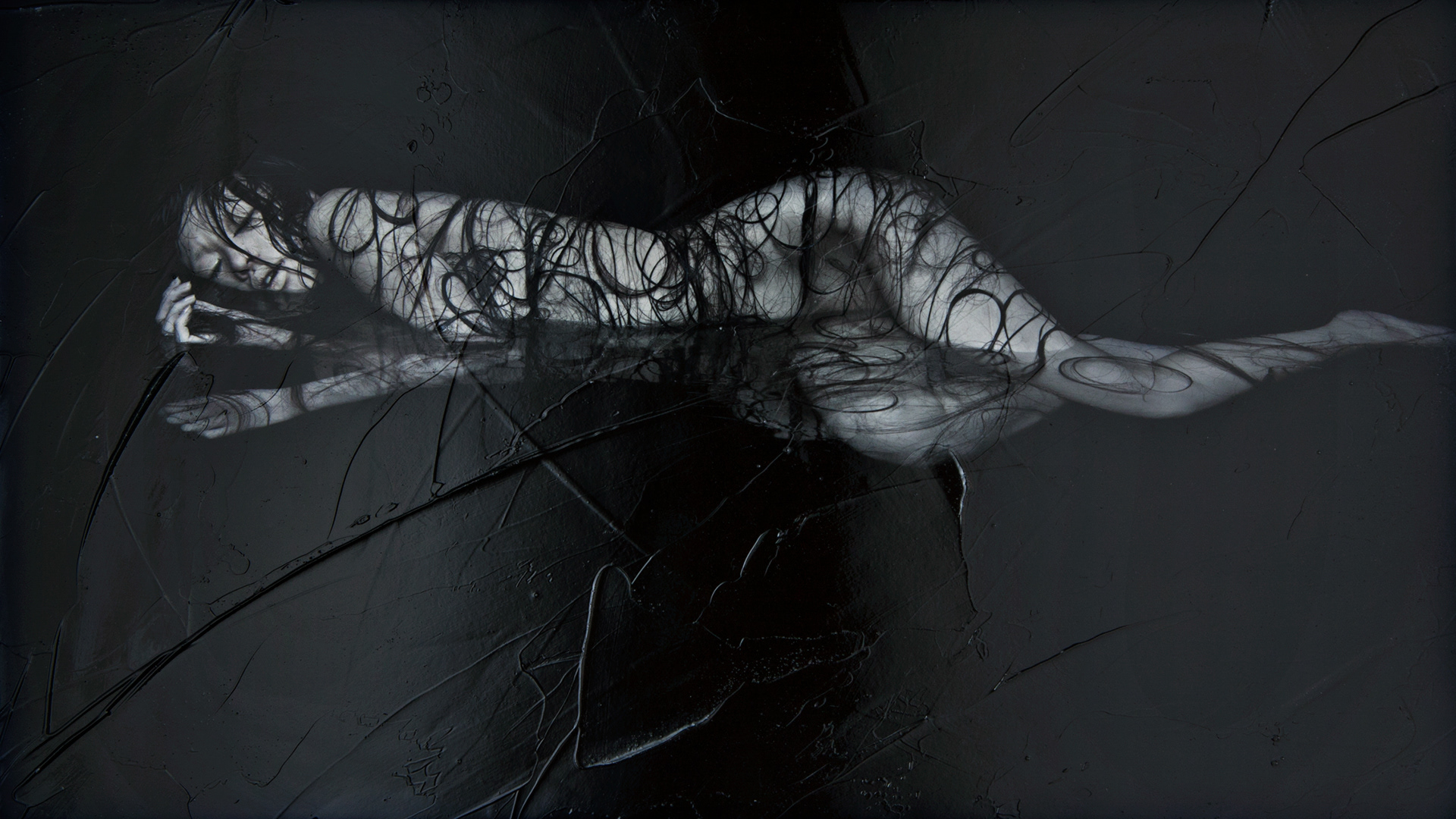
As we have noted, the artist has carried out three main series to date. The first is Wave, awarded first prize in Advertising at the International Photography Awards in 2007 and the Prix de la Photographie Paris in 2008.9
The result is impactful images of great tension. Through subsequent work on the photograph, in which the image is texturized through plaster, acrylic paint, varnishes, and other materials, greater drama and strength are achieved in the work.
On the other hand, Ikeya has carried out the Moon series, a song to life and death. In this work, water is also present, forming part of the creative and poetic process of the work. The phases of the moon influence the tides and also stimulate the development of life on Earth. This series is accompanied by the following text: "The dark night illuminated by the moon includes a mixture of life and death. / The potential of the body receiving a new life."10
Together, in this series, hair plays a fundamental role; hair remains for a long time on the person, even after they have lost their lives. Thus, hair would symbolize the continuity of life after death.
On the other hand, we cannot ignore the importance that hair has in the Japanese imaginary, as well as the binding that is done to the models with it. Ikeya recognizes that his work is strongly marked by the Shinto religion, in which, as is known, ropes are used to delimit what is considered sacred. Likewise, in Japan, there is a traditional art of binding, called shibari (縛り). We find this practice in the work of a very well-known Japanese photographer, Nobuyoshi Araki (Tokyo, 1940), who creates works in which he frequently arranges his models using this traditional Japanese art of binding. His influence on Ikeya's work goes beyond this, since, in the same way as in Araki's works, there is a dialogue between life and death. Despite this, the images never lose their elegance and delicacy (Fig. 6). This series was awarded at the International Photography Awards 2012 (second prize in the People category). We find this practice in the work of a very well-known Japanese photographer, Nobuyoshi Araki (Tokyo, 1940), who creates works in which he frequently arranges his models using this traditional Japanese art of binding. His influence on Ikeya's work goes beyond this, since, in the same way as in Araki's works, there is a dialogue between life and death. Despite this, the images never lose their elegance and delicacy. This series was awarded at the International Photography Awards 2012 (second prize in the People category).
The third and most recent of his series is Breath. Thanks to it, the artist has been awarded at the Prix de la Photographie Paris 2008, the International Photography Awards in 2009 (first prize in the People category and second prize in the Special category), Xto image award in 2010 (first place in Body in Nature), PX3 Prix de la Photographie Paris in 2010 (second place in Nudes), and Moscow International Foto Awards in 2014.11
To achieve these results, the artist makes use of Japanese performing arts, specifically Ankoku Butoh.12 Thus, some of his models are dancers of this contemporary dance that seeks to express situations in an extreme way.
For this reason, in the photographs, we can find very pronounced foreshortenings, torn gestures, or very visceral reactions. The models try to bring to light the deepest fears of the human being. The subjects live these situations to the limit, because being submerged underwater, fears surface with greater force. Nevertheless, despite the different reactions that occur in men, his work does not cease to be marked by enormous sensuality and beauty both in its forms and in its composition.
Together, we should note that, in addition to these three exposed series, Ikeya has carried out other photographic works, related to the world of fashion, for which he has also been awarded the Nude Jewelry prize in the Advertising - Catalogue of the International Photography Award in 2009, or has made video clips for some Japanese musical groups like Trus-Trick.
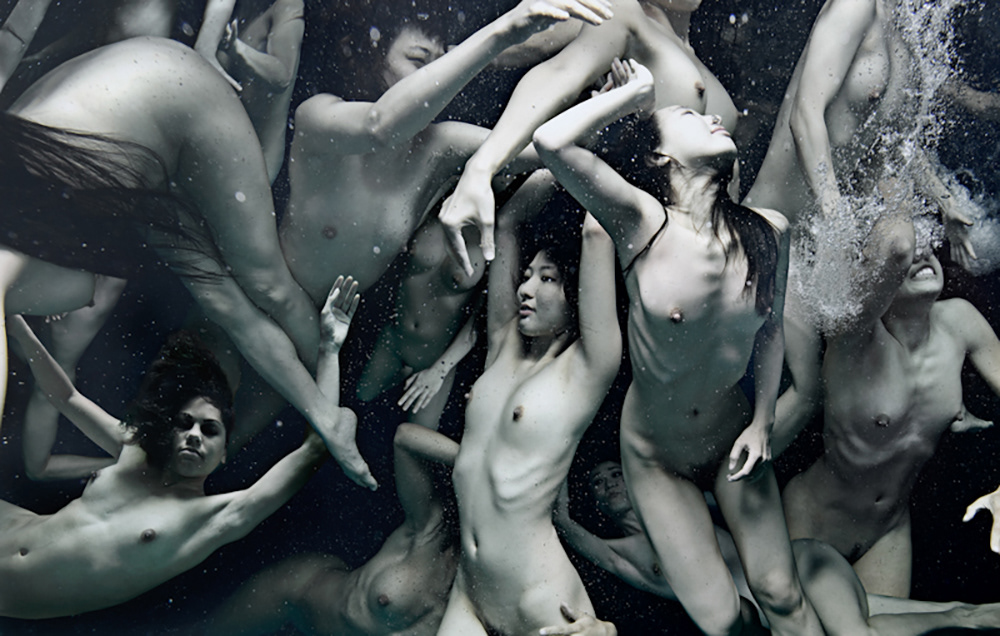


Conclusions
After what has been presented, we can conclude that, in recent years, Japanese artist Tomohide Ikeya has made a place for himself in the international contemporary art scene through his photographic works. This is demonstrated by the numerous awards obtained in the last decade, such as his participation in exhibitions and art fairs in Japan, Berlin, Paris, or New York.
Likewise, it is evident that despite being an emerging artist, his photographs stand out for their uniqueness and remarkable quality. With this study, we aim to immerse ourselves in the magnificent and disturbing work of Japanese artist Tomohide Ikeya and bring the work of the Japanese photographer closer to the national artistic scene.
Bibliography
BEVILLE, Ry (2010), "Breath: an Interview with Ikeya Tomohide", Koe magazine, Japan, 7, March 20, 2010. http://www.koemagazine.com/2010/03/ikeya-tomohide/ [01/04/18].
GALÁN, Fernando (2008), "Jun Nguyen Hatsushiba", in VV. AA., Miradas críticas en torno a la colección del MUSAC, Castilla y León, MUSAC.
IKEDA, Manabu (2008), Ikeda Manabu - The Pen, Kyoto, Seigensha Art Publishing.
IKEYA, Tomohide (2013), Breath, Japan, Libro Arte.
NAKAZAWA, Hideki (2014), Art History: Japan 1945-2014, Tokyo, Museum of Contemporary Art of Tokyo Bigakko.
MUNROE, Alexandra (1994), Japanese Art After 1945. Scream Against The Sky, New York, Harry N. Abrams.
MUNROE, Alexandra (2013), Gutai: Splendid playground, New York, The Solomon R. Guggenheim Foundation.
MUR, Jorge (2017), "Tomohide Ikeya, respiración bajo el agua", Culturamas, Madrid, 2017. http://www.culturamas.es/blog/2017/06/05/tomohide-ikeya-respiracion-bajo-el-agua/ [01/04/18].
TOSAS, Gina (2017), "La tragedia de ingerir mercurio", La Vanguardia, Barcelona, October 1, 2017. http://www.lavanguardia.com/internacional/20171001/431638690465/historia-anonima-enfermos-mercurio-minamata.html [01/04/18].
1. I would like to express my sincere gratitude to artist Tomohide Ikeya, as well as to Keiko Tanaka and Michele Vitucci, directors of the German gallery Micheko (which represents the Japanese author), for their collaboration in this research article, which has been fundamental. ↩
2. The date of 1945 marked a before and after in the history of Japan and similarly occurred in the arts. In the post-war period, Japanese art took a turn with respect to the type of art practiced until then, giving rise to a production very representative of the moment. The artistic languages of Japanese authors would be equated with the art produced in the international scene. An example is Sadamasa Motonaga (Mie Prefecture, 1922 - Kobe, 2011), who in 1956 participated with "Work Water" in the Gutai group's15 outdoor art exhibition, held in a park in Ashiya, Japan. ↩
3. This work can be consulted on the artist's website https://www.sugimotohiroshi.com/seascapes-1. Sugimoto captures these primordial landscapes from different points on the planet, transmitting the quietude and spirituality of Zen. His very conceptual photographs attempt to capture the essence of nature. ↩
4. This work can be consulted on the artist's website https://tatsuomiyajima.com. He filled the floor of the main room with water and placed LED devices inside that count from 1 to 9. He invited 125 local residents to participate in this project; they had to adjust the speed of each counter as they wished. The message this work tries to convey is clear: time connects us all, and in the same way, so does water. ↩
5. In the fifties, a chemical plant discharged, for years, thousands of residues into the sea that contained methylmercury, a derivative of mercury that causes serious brain damage and alterations in the nervous system. This work symbolically references the contamination of the Japanese town of Minamata, highlighting the importance of local folklore as well as the consequences of progress. At the same time, in this case as in others, water serves to establish a geographical relationship between different countries and cultures. The artist himself connects his Japanese and Vietnamese roots through the sea. ↩
6. The artist's website can be consulted at: http://tomohide-ikeya.com. Born in 1974 in this relatively small prefecture, located in the southwest corner of the Kanto plain on Honshu Island (between Tokyo and Mount Fuji) and bordered by the sea, it is not surprising to assume the artist's proximity to water and to the different environmental phenomena that occur there. ↩
7. The artist recognizes that he was considerably marked by the anime of Hayao Miyazaki (Nausicaä of the Valley of the Wind) and Rumiko Takahashi (Mermaid Forest). Information provided by artist Tomohide Ikeya through a telematic interview. In the 1990s, he worked in hospitality, specifically in an Italian restaurant in Japan.16 ↩
8. Japan Foundation in Mexico, Katsuji Takasaki: http://www.fjmex.org/v2/site/nota.php?id=2378sc=31 With him, Ikeya perfected his camera handling and lighting techniques, mainly the technical part. However, a year later, a specific event made Ikeya reconsider his professional career. ↩
9. Can be consulted at https://www.enkil.org/2011/10/18/tomohide-ikeya-agua-y-cuerpo. In the photographs belonging to this set, this struggle between human and water appears. In this case, man is a blockage, an obstacle that does not let the sea follow its course, but at the same time wants to be part of nature: resistance and integration. This series could be interpreted as follows: human beings try to face daily the problems that present themselves in their lives and, in some cases, are overwhelmed by them. We could say it is a metaphor for the violence individuals suffer in society.17 ↩
10. Can be consulted at https://www.enkil.org/2011/10/18/tomohide-ikeya-agua-y-cuerpo. Unlike the previous series, these photographs transmit an immense silence, producing an unsettling sensation in the viewer. ↩
11. http://www.micheko.com/kuenstler/tomohide-ikeya. These works focus on breathing, a vital activity of human beings that is controlled by ourselves. Ikeya seeks to make breathing visible and achieves it in the aquatic medium. In an interview, he explained the importance of this work: "Breathing is indispensable for us; it is repeated continuously during our life, and we consider death as the point at which breathing stops. Normally, breathing is invisible, and I think we are never aware of it."18 ↩
12. Ankoku Butoh, or dance of darkness, is an eclectic genre that combines dance, body expression, and performance. It emerged in Japan after World War II in reaction to the atomic bombs of Hiroshima and Nagasaki. ↩
14. Micheko Gallerie, website: https://www.micheko.com. The latter, moreover, is based on the premise of being a bridge between 21st-century Japanese art and European collectors. Its objectives are to change the perception, the visual habits, of art enthusiasts outside Japan, as well as to increase awareness about contemporary art from the Land of the Rising Sun.19 ↩
15. The artistic group Gutai Bijutsu Kyokai was founded in 1954 by Jiro Yoshihara (Osaka, 1905 - Ashiya, 1972) and dissolved upon his death. This movement, which emerged in the Kansai region (Osaka, Kobe, and Kyoto) and which included such relevant creators as Sadamasa Motonaga, Shozo Shimamoto, Saburo Murakami, Kazuo Shiraga, Toshio Yoshida, Akira Kanayama, and Atsuko Tanaka, among others, opted for new forms of creation and reflected post-war Japan (marked by its defeat in World War II) through different artistic manifestations, highlighting their performances, happenings, installations, experimental films, or concrete music. It was an installation composed of a series of vinyl sheets filled with colored water. Originally hung between trees in the park like hammocks, gravity caused the vinyl to curve, allowing the water to gather at the bottom. Simultaneously, sunlight hit the compound, which changed throughout the day and resembled hanging jewels. ↩
16. Ibid. In 2001, he decided to train as a photographer and began studying this discipline at 東京綜合写真専門学校 (Tokyo Sōgō Shashin Senmon-Gakkō) or Tokyo College of Photography.20 ↩
17. Can be consulted at http://www.rafaelroa.net/tomohide-ikeya. Likewise, there are other factors that allow resisting or desisting in the face of these 'waves' or obstacles, such as the strength or weakness of each one, the emotional state, gender, or age. ↩
18. http://elhurgador.blogspot.com.es/2015/05/fotografos-japoneses-viii-tomohide-ikeya.html. An infinite number of bubbles allows us to see the breath with total clarity. Equally, underwater, the attitude of human beings during their lives becomes evident: some have the desire to live and fight for it, others let themselves be carried away by the different situations that present themselves, and some simply abandon themselves. In an interview, the artist told us: "People encounter all kinds of problems during their lives. Even if someone breaks down a barrier that prevents them from doing something with their own hands, this will not change the fundamental essence of our own limitations. These limitations, too, are part of 'living'."21 ↩
19. Information provided by artist Michele Vitucci, director of Micheko Gallerie, through a telematic interview. ↩
20. The Tokyo College of Photography was established in Nakano (Tokyo), in 1958, as the Tokyo Photographic School. In the sixties, it moved to Hiyoshi (Yokohama), where it is currently located. See the website http://tcp.ac.jp We should remember that contemporary Japanese photography is very recognized worldwide for bringing together great photographers of the 20th and 21st centuries such as Shomei Tomatsu, Eikoh Hosoe, Daido Moriyama, and Nobuyoshi Araki, among others. For this reason, it is not surprising that many Japanese are interested in this medium. The artist was able to delve deeper into this discipline and gradually became acquainted with other Western authors such as Irving Penn, Richard Avedon, Nick Knight, and Peter Lindbergh, whom he admires and is aware of the mark they have left on his work.22 ↩
21. Information provided by artist Tomohide Ikeya through a telematic interview. ↩
22. Information provided by artist Tomohide Ikeya through a telematic interview. ↩